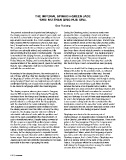Page 132 - Bonhams Chinese Works of Art June 2015 Hong Kong
P. 132
THE IMPERIAL SPINACH-GREEN JADE
‘SHUI MU ZHAN QING HUA’ SEAL
Guo Fuxiang
The present extraordinary imperial seal belonging to During the Qianlong period, numerous seals were
the Jiaqing emperor is made of spinach-green jade and grouped in three, comprising a head seal and two
the knob is carved with a dragon crouching on his four accompanying seals. Such particular seal groupings can
legs amidst cloud scrolls. It is 4.2cm square and 7cm be further categorised into two sub-types. The first type
high, incised with five characters Shui mu zhan qing bears a pavilion’s name as the head seal and two poetic
hua (‘Tranquil water and luxuriant trees in the garden’). phrases on the accompanying seals, explaining the
The carvings on both the seal knob as well as the seal origin and history of that particular pavilion. The second
itself are exceptionally refined and meticulous, fully type bears three closely related proverbs as inscriptions,
demonstrating the high level of craftsmanship. This seal constituting a ‘proverbs seal set’. The Jiaqing emperor
is recorded in the Jiaqing Baosou, a catalogue of the certainly followed suit and created at least seventy sets
Jiaqing emperor’s imperial seals, now preserved in the of seals of similar format.1 The present imperial
Palace Museum, Beijing, and is undoubtedly a genuine spinach-green jade ‘Shui mu zhan qing hua’ seal falls
imperial artefact of the Jiaqing period, given its matching into the first type of such conscientious seal grouping.
texture, size, calligraphic style and composition of the
seal with the recorded one. There is no doubt that the Jiaqing emperor deliberately
followed his father for his aesthetic merit, as reflected
According to the Jiaqing Baosou, this seal is part of a in the form and craftsmanship of this seal. The seal
set of three, with the other two bearing the inscriptions inscriptions, on the other hand, reveal more of the
of Qinghuige (‘Pavilion of Purity and Sunlight’) and Yun ri Jiaqing emperor’s personal feelings and thoughts during
xiang hui ying (‘Cloud and sun brightening each other’), his reign. As mentioned above, the present imperial
confirming that this set of seals was created specifically seal belongs to a set of three seals where the first
to be stored in Qinghuige within the Yuanmingyuan. denotes the name of an imperial hall or pavilion. This
combination was favoured by the Qianlong emperor and
The Jiaqing emperor, whose given name is Yongyan, was followed by his fifteenth son when he ascended
was the fifth emperor in the Qing dynasty. Prosperity the throne. In the case of the ‘Shui mu zhan qing hua’
continued from the Kangxi and Qianlong periods and seal, as it belongs to a set of three seals especially made
through Jiaqing’s 25 years of ruling; yet Jiaqing’s reign for use in the Qinghuige within the Yuanmingyuan, it
period indicates a critical point in the Qing dynasty, is necessary to study and take into consideration the
with the downfall of the nation following his reign. inscriptions carved on the two other seals, which would
This suggests a complicated state of affairs for both have comprised the set, and the historical context of the
the Jiaqing emperor and the nation. Among the Qing place in relation to the Jiaqing emperor himself.
emperors, the Jiaqing emperor owned a relatively
substantial collection of seals, with the qualities and Qinghuige was located in the western part of
style of the seals exemplifying the characteristics of Jiuzhouqingyan, an imperial palace complex built north
such a transitional period. Despite being crowned at of the Qianhu Lake within the Yuanmingyuan. Three main
36, the emperor enjoyed little political power during palaces, the Yuanmingyuan Palace, the Fengsanwuci
the first five years of his reign. Instead, the emperor Palace and the Jiuzhouqingyan Palace stood along
emeritus, Qianlong, continued to carry out the ultimate the complex’s main axis, forming the core part of the
rulings. Under this particular circumstances, it was Summer Palace. To the east of the main axis was the
not easy for the Jiaqing emperor to separate himself Tiandiyijiachun Palace, where the Daoguang emperor
from certain formats that were well-established in the was born, and to the west was the residence of the
former reign. These formats were maintained during the Qianlong emperor, the Le’anhe Palace. Qinghuige was
Jiaqing period and are distinctly represented in his seals, built on a terrace further to the west of the Le’anhe
especially in the way of grouping the seals. Palace. The palaces within the complex that were
built during the Kangxi period are among the earliest
constructions in the Yuanmingyuan.
130 | BONHAMS

